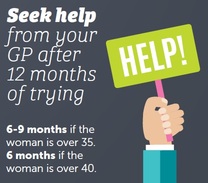The Drugs Used in Fertility Treatment
Ovulation induction drugs
Many women do not ovulate spontaneously, and require some form of drug regime to stimulate the ovaries into producing a follicle.
In other treatments such as IVF the role of the drugs is to stimulate more than one follicle to develop.
Clomiphene citrate
Clomiphene as 50mg tablets, are taken for 5 days near the beginning of the menstrual cycle – commonly Days 2-6, or Days 5-9. The dose prescribed may vary between 25mg to 150mg, depending on the amount needed to induce follicle growth.
Clomiphene acts by blocking the oestrogen receptors in the hypothalamus and pituitary gland. This causes the pituitary gland to continue producing FSH in higher levels for the 5 days of medication. The effectiveness of the Clomiphene treatment is measured with estradiol blood tests, a follicular scan and a blood test for progesterone about 7 days after ovulation. The dose of the drug can then be altered in subsequent cycles, according to individual requirements.
For some women, the drug Letrozole may be used as an alternative to Clomiphene
Gonadotrophin injections
Recombinant FSH
- Gonal F and Puregon
These drugs are FSH (follicle stimulating hormone) manufactured synthetically, but are virtually identical to the body’s own hormones. The drugs act directly on the ovary. They are given in a variety of doses. For ovulation induction, the starting dose is 50-75iu a day, which can be gradually increased until a rise in oestrogen production is detected which shows follicles are growing.
For IVF, the starting dose will vary from 150 - 300iu per day depending on several factors such as age, BMI and AMH level. The starting dose may be lower in the case of Polycystic Ovaries. The effectiveness of the drugs is monitored with blood levels of estradiol, and ultrasound scans of the
follicles in the ovaries.
These injections are administered into the fatty tissue just under the skin (subcutaneous), and most women are able to give these to themselves. They should be given at a similar time each day, usually in the evening.
- Elonva
Elonva is an artificial FSH that lasts for 7 days after a single injection. It can be used as an alternative to Gonal F or Puregon to start stimulation.
Menotrophin HP
- Menopur
Menopur contains two hormones called follicle stimulating hormone (FSH) and luteinising hormone (LH). The FSH and LH in Menopur are natural hormones which are highly purified. This drug acts directly on the ovary.
Other drugs used in ART
Gonadotrophin Releasing Hormone (GnRH) agonists.
• Buserelin is a super-strong version of GnRH. Its initial effect is to raise the levels of FSH and LH, and after a period of time it actually blocks the release of these two hormones from the Pituitary gland. Because it blocks the release of LH, it is often used to prevent premature ovulation in IVF cycles.
It is used in 2 different regimes for IVF – on the ‘Long Course’ it is used from Day 21 of the cycle, and after a couple of weeks of injections a blood test is done to check for down-regulation. This ensures the woman’s hormones are low and ready to start the FSH injections.
In the ‘Short/ Flare Course’ it is commenced around Day 2 of the cycle, and then the FSH injections are commenced a couple of days later to take advantage of the Flare FSH production from the Pituitary gland.
Buserelin is administered by subcutaneous injection, at a similar time each day. The dose is 200-400mcg, depending on the drug regime used.
• Lucrin is another version of GnRH agonist, like Buserelin.
Cetrotide or Orgalutran
These drugs are GnRH antagonists. Cetrotide and Orgalutran both work by reducing the body’s release of LH, and in doing so reduce the risk of premature LH surges that can affect IVF cycles. They are given as subcutaneous injections from around Day 6 or 7 of FSH stimulation, until trigger / ovulation time in an IVF cycle.
Ovidrel
This is used for ‘triggering’ ovulation. The Ovidrel acts in a similar way to the natural surge of LH that triggers ovulation, by maturing the egg and causing the follicle to rupture. Egg collection in IVF or insemination in other treatments is usually timed 36 hours after the Ovidrel injection. The dose given is 250ug as a subcutaneous injection.
Utrogestan
This is a vaginal pessary containing Progesterone. Utrogestan is used to help support the lining of the uterus when the ovaries themselves may not produce enough progesterone. The pessaries are inserted into the top of the vagina, near the cervix, to allow absorption of the hormone into the bloodstream and uterus. They are 100mg, and the usual dose is two pessaries at 8 hourly intervals, commencing soon after egg collection. The progesterone is rapidly absorbed and metabolised by the body which is why it is important that Utrogestan given at regular intervals to maintain a constant level in the blood.
If a pregnancy occurs then Utrogestan may be continued for up to 10 weeks, or stopped earlier if the woman is producing sufficient levels of progesterone from her ovaries.
Crinone
This is a progesterone gel, which is used in luteal phase support following IVF treatment. The gel comes in a pre-filled applicator, containing
90mg of Progesterone. It is given at a dose of 90mg, usually once daily but may be up to twice daily. The applicator is inserted into the vagina, and the gel is then placed near the cervix. It is started within 4 days of the HCG trigger injection and is used until the pregnancy test.
Gestone
This is an intramuscular injection of Progesterone. It is a thick oily solution that must be given into the muscle rather than the fatty layer under the skin. It is given if the woman does not absorb sufficient levels of progesterone from the Utrogestan. Its dose is usually 100mg per day, which is 1 injection each day, for a similar length of time as the Utrogestan pessaries.
Other drugs that may be used in ART
• Provera – progesterone tablets are commonly used to induce a bleed prior to treatment with stimulating drugs. The artificial hormone increases the lining of the uterus, and when the drug is stopped the drop in hormone level causes a withdrawal bleed, and the shedding of older endometrium. It may also be given in early pregnancy to supplement progesterone levels.
• Oral contraceptive – a woman may be required to take this prior to IVF treatment, to reduce the occurrence of ovarian cysts and regulate the menstrual cycle. It provides artificial Oestrogen, which inhibits the production of FSH and consequently the formation of a follicle in the ovary.
• Progynova or Estrodial Valerate – is an artificial oestrogen, which is commonly used to ‘manufacture’ artificial menstrual cycles during egg donation or the transfer of frozen embryos. It is given from day 2-4 of the cycle for a menstruating woman or at a designated date for a non-menstruating woman. The oestrogen increases the endometrial lining of the uterus, in preparation for embryo transfer. When this drug is used in a manufactured cycle, it needs to continue for 10-12 weeks if the woman becomes pregnant. Utrogestan is used in conjunction with Progynova, and it too must continue if pregnancy occurs in a manufactured cycle. The placenta begins production of oestrogen and progesterone after 8-10 weeks gestation, and should be able to maintain the pregnancy from 10-12 weeks.
Ovarian Hyperstimulation Syndrome (OHSS)
This is the most serious ‘potential’ complication that can arise from IVF treatment. The most important aspect in the management of OHSS is to try and avoid it! Women who are known to have Polycystic Ovary Syndrome (PCOS) are given a lower dose of FSH than other women, as they are more likely to over-respond to the drugs. However, even women who do not have PCOS may over-respond to the lower dose of drugs.
Monitoring of estradiol levels and vaginal scans to measure and monitor follicular growth is an important part of managing an IVF cycle, to try and give enough but not too much ovarian stimulation. If, despite these measures, there is a reasonable risk of ovarian hyperstimulation, the cycle may be stopped without Ovidrel being administered. Without Ovidrel, OHSS can be avoided.
Another option is to proceed with egg collection, but to freeze all the embryos instead of replacing any. This is because OHSS is more common when women become pregnant.
When the ovarian stimulation uses Cetrotide or Orgalutran, there is another strategy to reduce the chance of OHSS. Ovulation can be triggered by Buserelin instead of Ovidrel – with all embryos frozen. Signs and symptoms of OHSS are abdominal bloating and pain, often associated with nausea and diarrhoea. Increased weight, decreased urine production and shortness of breath are other symptoms. Ultrasound would show enlarged ovaries, with free fluid in the pelvic cavity and abdomen. The free fluid is called ascites. Sometimes there is fluid collection around the lungs (pleural effusion), and this causes the shortness of breath.
These symptoms are caused by changes in metabolism, which cause fluid to escape from the blood vessels into the body cavities, resulting in thickening of the blood and an increased risk of blood clotting. Many patients will develop mild symptoms of distension and discomfort, which can be managed with pain relief, rest and increased fluid intake at home. The clinic will monitor ovarian activity with scans, and blood tests to check blood consistency. Daily weighing and girth measurements are also important, and an increase in these indicates increasing risk of OHSS.
If nausea, pain or shortness of breath are a problem then hospitalisation will be necessary, and the patient will have intra-venous fluids (a drip) administered. ‘Heparin’ will be given to decrease the risk of clotting, and occasionally if the abdomen is very distended and uncomfortable some of the excess fluid may be withdrawn using a needle under local anaesthetic, and a drainage tube inserted into the abdomen. This will relieve the symptoms, but the fluid rapidly re-accumulates.
OHSS is self-limiting, and resolves with the next menstrual period. However, it may last longer if the woman is pregnant, although usually in a less severe form than the initial symptoms.



